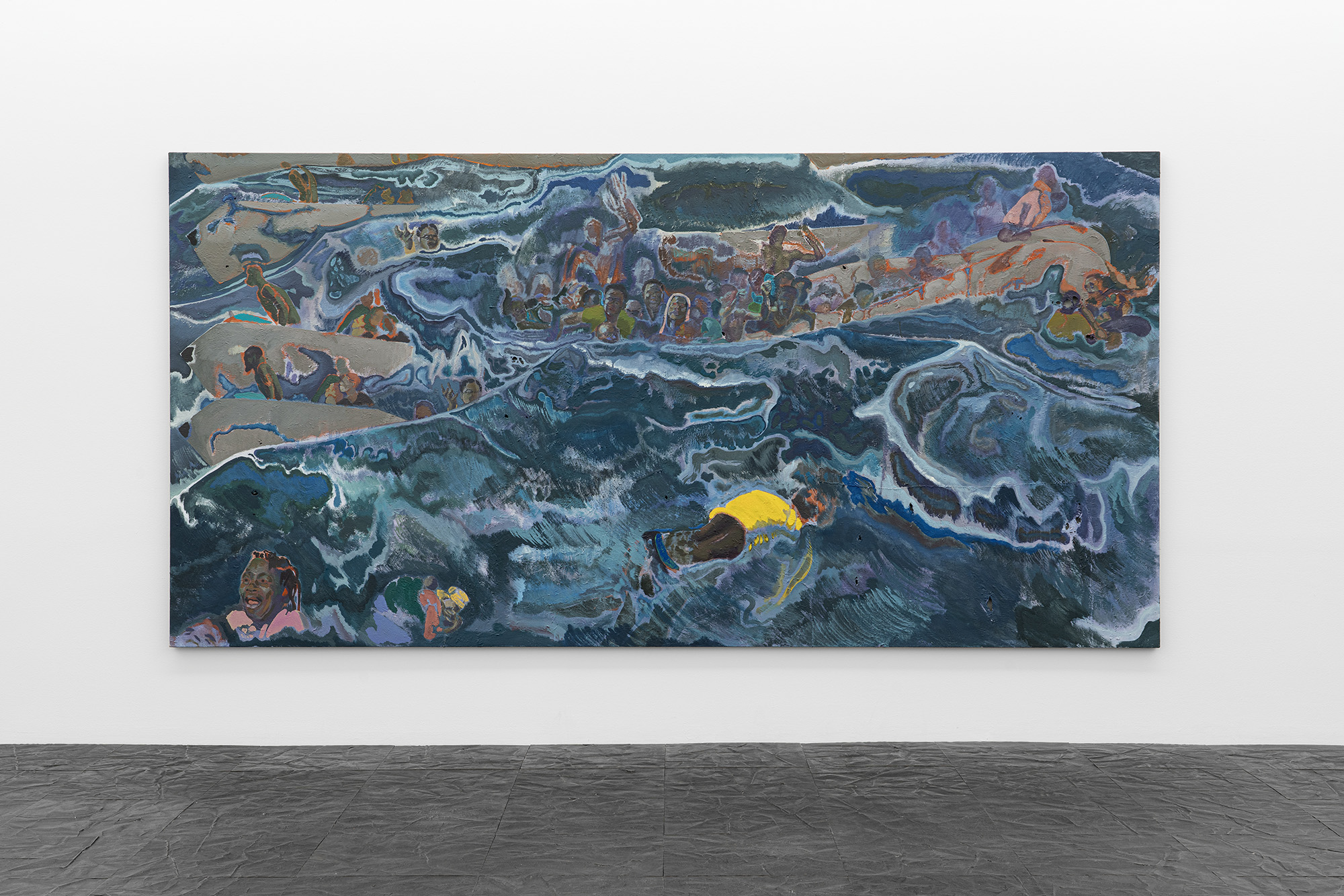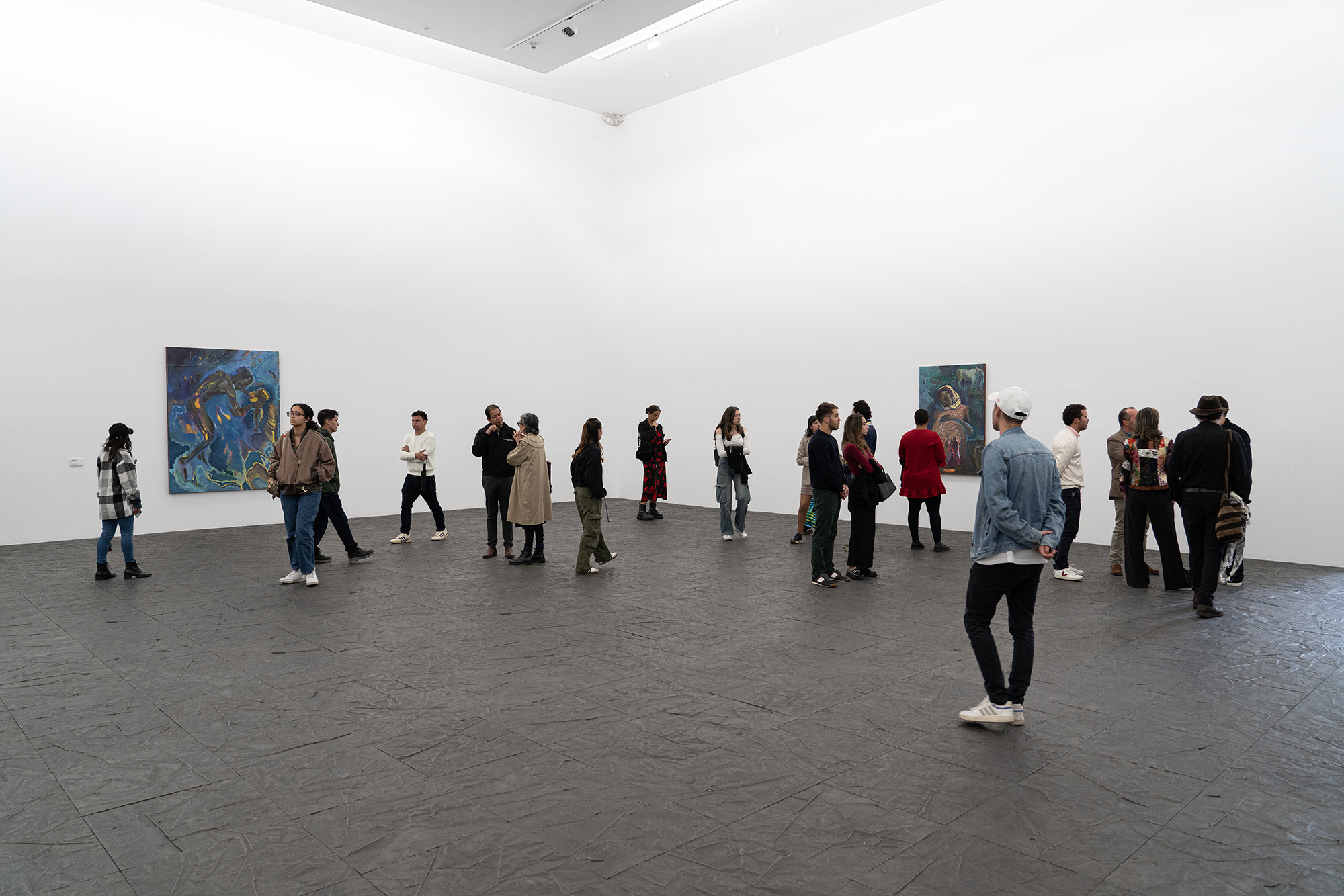
BALSA, del artista nacido en Kenia Michael Armitage, reflexiona sobre la tragedia de la migración como fenómeno global y, a su vez, como experiencia vital, política y simbólica. Inspirado en sucesos históricos y realidades sociopolíticas concretas –en este caso, las experiencias de quienes intentan llegar a Europa atravesando el Sahara y el Mediterráneo–, el artista alude al mismo tiempo a la dimensión universal de la migración como experiencia humana. Las cuatro pinturas que conforman esta serie representan figuras poderosas y a la vez vulnerables, que encarnan el sufrimiento y la resiliencia. En estas obras, Armitage plantea un cuestionamiento acerca del exilio, el desarraigo, el duelo y la ruptura cultural.
Esta serie de pinturas surge como respuesta a las tragedias sufridas por migrantes, como la historia de una joven eritrea secuestrada por una milicia en Libia durante su travesía hacia Europa, o el naufragio de un barco de refugiados en Lampedusa en 2013 –donde murieron al menos 368 personas–, o bien la estremecedora imagen de Aylan Kurdi, el niño sirio de tres años que falleció ahogado junto a su madre y su hermano en un intento desesperado por alcanzar Europa y huir de la guerra.
Armitage es reconocido como una de las voces más relevantes de la pintura contemporánea, dada la complejidad técnica, la riqueza formal de su obra y el hecho de que en ella la figuración adquiere un carácter casi mítico. Su propuesta establece un diálogo entre la cultura visual contemporánea y la historia del arte: sus referentes incluyen a Goya, Tiziano, Manet y Gauguin, así como el legado de la pintura moderna, en un movimiento constante que se aproxima a la par que se distancia de la tradición cultural de Occidente. Al mismo tiempo, su obra se nutre de influencias del África oriental, entre ellas, las de Theresa Musoke, Jak Katarikawe y Chelenge Van Rampelberg.
Estas pinturas de gran escala son emocionalmente intensas: imágenes de colores oscuros y profundos, atravesadas por fuertes contrastes, visceralidad y múltiples capas de realidad, en las que irrumpen elementos desestabilizadores.
Armitage emplea como soporte el lubugo, un textil tradicional de Uganda, elaborado a partir de una corteza de árbol mediante una técnica con siglos de historia. Se trata de una tela ceremonial para la etnia baganda, empleada como mortaja en sus ritos funerarios. El material, con sus visibles suturas e irregularidades, determina también las decisiones formales y aporta una carga simbólica que sitúa geográficamente la obra.
En el diálogo entre sus pinturas y este espacio de arte y memoria se articulan una conmemoración y un homenaje a migrantes y refugiados, así como a quienes han perdido la vida en ese tránsito: hombres, mujeres y niños valientes, borrados y abandonados. Sus historias están atravesadas por desigualdades estructurales, racismo sistémico e injusticias ambientales y sociales. La crisis migratoria evidencia las fisuras de los mitos democráticos y humanitarios de Occidente.
La propuesta artística de Armitage es una forma de habitar y experimentar el mundo, pero también una materialización capaz de impactarlo. Su obra señala el camino de regreso a la comunidad, a la construcción colectiva, a la recuperación de un sentido de humanidad y a una experiencia universal compartida.
BALSA, by Kenyan-born artist Michael Armitage, reflects on the tragedy of migration as both a global phenomenon and a vital, political, and symbolic experience. Rooted in historical events and specific socio-political realities—in this case, the experiences of those attempting to reach Europe by crossing the Sahara and the Mediterranean—the artist simultaneously alludes to the universal dimension of migration as a human experience. The four paintings that make up this exhibition portray figures that are at once powerful and vulnerable, embodying both suffering and resilience. In them, Armitage turns his gaze to exile, displacement, grief, and cultural rupture.
This series of paintings emerges as a response to tragedies endured by migrants, such as the story of a young Eritrean woman kidnapped by a militia in Libya during her journey to Europe; the shipwreck of a refugee boat off Lampedusa in 2013—in which at least 368 people died; or the haunting image of Alan Kurdi, the three-year-old Syrian boy who drowned along with his mother and brother in a desperate attempt to reach Europe and escape the war.
Armitage is regarded as one of the most relevant voices in contemporary painting, due to the technical complexity and formal richness of his work, and to the way in which figuration in his work acquires an almost mythical character. His practice establishes a dialogue between contemporary visual culture and the history of art: his references include Goya, Titian, Manet, and Gauguin, as well as the legacy of modern painting, in a constant movement of approaching and distancing himself from the cultural tradition of the West. At the same time, his work draws from East African influences, including Theresa Musoke, Jak Katarikawe, and Chelenge Van Rampelberg.
These large-scale paintings are emotionally intense: images of dark, deep colors, marked by sharp contrasts, visceral force, and multiple layers of reality where destabilizing elements erupt into view.
Armitage works on lubugo, a traditional Ugandan bark cloth crafted through a centuries-old technique. Used ceremonially by the Baganda people and as a burial shroud in their funeral rites, the material—with its visible seams and irregularities—also shapes formal decisions and adds a symbolic dimension that anchors the work geographically.
The dialogue between these paintings and this space of art and memory articulates a commemoration and a tribute to migrants and refugees, as well as to those who lost their lives along the way, courageous women, men, and children, erased and abandoned. Their stories bear the marks of structural inequalities, systemic racism, and social and environmental injustices. The migration crisis exposes the fissures in the democratic and humanitarian myths of the West.
The art Armitage proposes is both a way of inhabiting and experiencing the world, and a materialization capable of impacting it. His work points toward a return to community, to collective construction, to the recovery of a sense of shared humanity.
